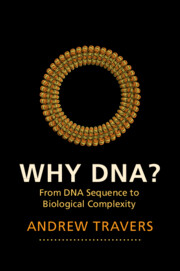Book contents
- Why DNA?
- Frontispiece
- Why DNA?
- Copyright page
- Contents
- Preface
- Acknowledgements
- 1 The Perennial Question
- 2 The Nature of Biological Information
- 3 DNA
- 4 The Evolution of Biological Complexity
- 5 Cooperating Genomes
- 6 DNA, Information and Complexity
- 7 Origins of Complexity
- 8 The Complexity of Societies
- 9 Why DNA
- General Reading and Bibliography
- Index
3 - DNA
The Molecule
Published online by Cambridge University Press: 05 May 2022
- Why DNA?
- Frontispiece
- Why DNA?
- Copyright page
- Contents
- Preface
- Acknowledgements
- 1 The Perennial Question
- 2 The Nature of Biological Information
- 3 DNA
- 4 The Evolution of Biological Complexity
- 5 Cooperating Genomes
- 6 DNA, Information and Complexity
- 7 Origins of Complexity
- 8 The Complexity of Societies
- 9 Why DNA
- General Reading and Bibliography
- Index
Summary
Today the feature of DNA that defines the molecule is the fact that the two strands are entwined as a right-handed double helix. In common parlance, DNA is ‘the double helix’. While this double-helical character is not required by the base complementarity per se – a simple straight ladder structure would fulfill this function just as well – it does impart crucial physical and chemical properties to the polymer. It is these properties that play a major role in the biological function of DNA. The genetic functions of DNA can thus be understood as the synergism of two properties – a tape containing the information store encoding the sequences of proteins and RNA molecules and a polymer existing as double-helical string enabling the packaging, accessibility and replication of the information store. Crucially not only the coding of proteins and RNA molecules but also the physicochemical properties of the polymer are specified by the base sequence.
- Type
- Chapter
- Information
- Why DNA?From DNA Sequence to Biological Complexity, pp. 53 - 92Publisher: Cambridge University PressPrint publication year: 2022



